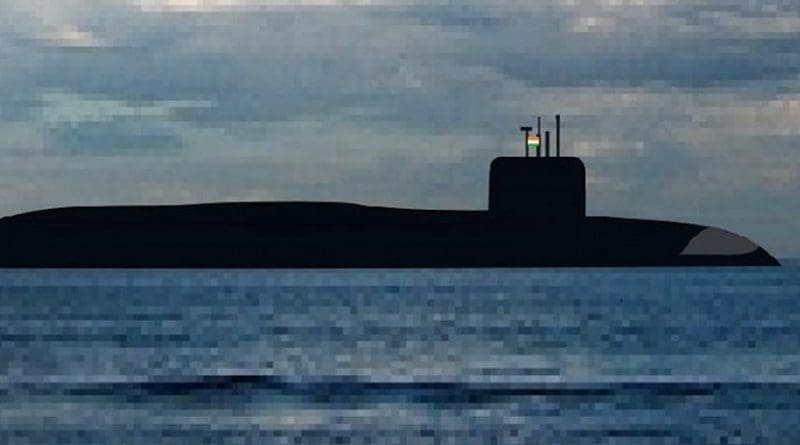INS Arihant Accidents: Question Mark Regarding Sustainability Of India’s Naval Force – OpEd
By Sonia Naz*
The Indian navy inducted first indigenously built nuclear-armed submarine, the INS Arihant in 2009. It was jointly developed by the Indian Navy, Bhabha Atomic Research Centre (BARC) and Defence Research and Development Organization (DRDO) at the naval shipyard in Visakhapatnam. Russian engineers assisted in building the vessel.
India has leased 16 diesel-electric submarines from Germany and Russia. However, the weakness with diesel electric submarines is that they cannot stay under water for a long time. Conventional diesel-electric submarines have to ascend to the surface each day to discharge carbon dioxide produced by the generator. Nuclear-powered submarines can stay under water for long durations without being detected. Many observers claim thatit is first operational Ship Submersible Ballistic Nuclear (SSBN) asset of India which can stay hidden deep underwater for a long period. According to them it would also play an increasing role in the country’s nuclear deterrence because it is capable of launching ballistic missile carrying nuclear warheads from the depth of the ocean.It has four sea-launched ballistic missile (SLBM) tubes. Its four tubes have the capability to operate a short range SLBM (K-15 Sagarika) estimated at 750 km and future versions of the class will be capable of firing long range (estimated at 3,500 km) K-4s.Arihantis operated by 100 men with extensive training from the School for Advanced Underwater Warfare in Visakhapatnam. India now joins a small group of states that are capable of indigenously building nuclear submarines. Indian former Prime Minister Manmohan Singh, professed that the indigenously built submarine would be used for self defence. The name Arihant originates from two words “Ari’ meaning enemy and “Hant” meaning destroy.
Some observers also claim that the emergence of the INS Arihant raises India’s status as a rising naval power because its deployment in the Indian Ocean will strengthen Indian naval force projection. The reality is that Arihant has faced many accidents, and if it could not save itself from those mishaps how could it possibly raise the status of India? INS Arihant, has suffered major damage and has been out of commission for more than nine months in 2018.The cause of the damage is the water that rushed in because a hatch on the left side remained open by mistake. India has never established a nuclear submarine before, has never operated an SSBN, and holds very limited experience.Not only now it possesses a damaged Arihant, but it also puts a question mark on the Indian$2.9 billion project and naval force.
The Arihantcase is not astonishing because Indian navy doesn’t show a good record in recent years in handling its conventional and nuclear-powered submarine forces. Before, the damage of Arihant India faced an accident of INS Chakra which was leased from Russia.In 2013 INS Sindhurakshak after the Kilo-class submarine agonized a major detonation during berthing in Mumbai. This incident was caused by human error and has taken the lives of eighteen sailors. In 2014, INS Sindhuratna, an Indian Kilo-class submarine, experienced a fire incident on board and two crewmen died in this incident due to asphyxiation.That incident didnot occur due to the human error, but because of the poor maintenance of the vessel.
Most scholars claimed that the SSBN force may have serious effects on Pakistan and China with endangering arms race in the region. Simply it is not reality, because India’s navy could not improve submarine operations and maintenance and it is facing technical difficulties. The first technical challenge is the successful integration of ballistic missiles with the nuclear submarine. India could not make considerable progress in developing underwater deterrence.It needs more efforts to overcome all these technical problems to launch a robust triad. It is not difficult to predict that a fully operational nuclear submarine would take 10 to 20 years. The first few submarines, including, INS Arihant is as a technology demonstrator rather than a vigorous deterrent projector. Arihant has faced many problems from the start and still experiencing repairs for damage. The performance of these vessels belongs to the first and second generation of SSBNs. For the sea based deterrence India needs S-5 vessel and a powerful reactor,which will take two decades more.
About the author:
*Sonia Naz, Research Associate at Strategic Vision Institute Islamabad
Source:
This article was published by Modern Diplomacy.


Maintenance and training are key to an effective force. Both need improvement in the case of India. Compared to the U.S India is way way behind in both. The fault lies with the leadership.
Corrected:
One more pakistani piece with no historical context or knowledge regarding submarines.
By the same yardstick, China’s Type 091 SSNs (people died through exposure to radiation) and Type 092 SSBNs (technically so faulty, it stayed at the pier almost all its life) issues should mean China has no right to keep submarines too. So does Russia by extension and so do France and UK (collisions, 1994 accident)
If China can have SSNs etc., Why cannot India respond? this pakistani logic or lack of it is always baffling. Somehow India needs to be weak while every other accident in every other navy is set aside.
PS: the spelling mistakes and lack of space at many places is hideous. Sonia Naz, please do a bit of decent proof reading before you post. This comes before scientific verification.
Irregardless of the Pakistani bias, it is also true that India has an ill trained manpower. They lack attention to detail. In my own conversation with India’s naval personnel who had taken part in the Malabar exercises, placed themselves in the Dark Ages compared to the Americans in training.